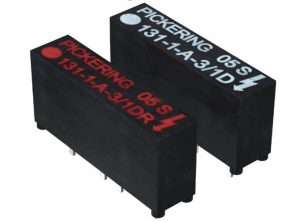
Modifications of the 119 and 131 series, both Series 119L and 131L Relay ranges have been specifically developed for mixed-signal applications where low and stable contact resistance is important for the end user’s application.
They have a slightly lower stand-off voltage than standard (up to 1.5kV) but have extended contact stability testing completed over 2,000 operation cycles, at a low-level switching load as part of the standard production testing.
Pickering engineer Robert King explained the issues to Electronics Weekly:
A characteristic of the switch used in this range is the contact resistance can increase over time if subjected to stand-off voltages in the upper range of the specification.
The electrostatic charge across the contact gap can cause material to be attracted to the contact surfaces resulting in contact resistances increasing with time to over 1Ω.
When switching levels great enough to generate an arc, this material is easily displaced and in most high voltage applications this characteristic does not occur, or any increase in contact resistance has no effect on the performance or life expectancy.
However, in some mixed-signal applications where low level or cold switching takes place, low and stable contact resistance is important.
For this reason, Pickering offers both a low-level and a general-purpose option for all package types, the low-level parts have a reduced high voltage stand-off and are tested for extended contact resistance stability as part of the production testing.
Data sheets
Series 119L (with Series 119)
Series 131L (with Series 131)